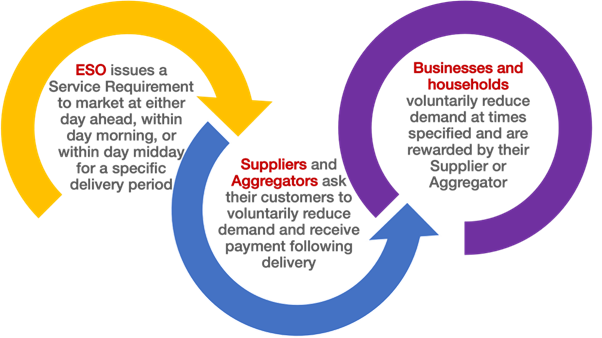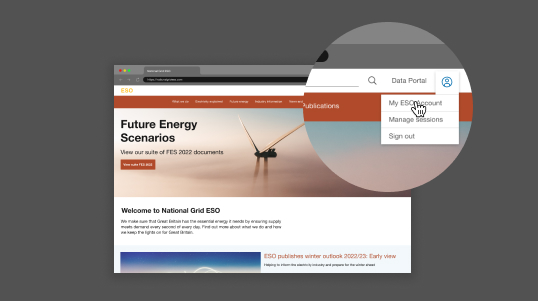What is the Demand Flexibility Service?
The Demand Flexibility Service (DFS) allows you to earn rewards for shifting electricity usage outside of peak demand hours. This allows the Electricity System Operator (ESO) to manage supply through periods when margins are tight.
The DFS was introduced in winter 2022/23 and over 1.6m households and businesses participated, providing ~350MW of flexibility to the ESO. In the ESO we make sure that Great Britain has the essential energy it needs by ensuring supply meets demand every second of every day.
How does it work?


Share your ideas on the future of the Demand Flexibility Service (DFS)
Are you interested in the evolution of DFS? Following our recent webinar, please share your feedback and ideas with us on what the DFS could look like moving forward.
The questionnaire can be accessed below and will remain open until 19 April.
If you have any questions, contact us at: [email protected].
Domestic Households
More information for households looking to get involved in DFS can be found on the electricity explained section of our website.
Industry and commercial
Please read our open letter to find out more about participating in DFS as a business.
How to become a registered provider
Are you interested in becoming a registered provider for the Demand Flexibility Service? Here’s a quick guide to getting set up.
1: Contact our Demand Flexibility Service team to arrange an introductory call
Let us know about your campaign and your audience and we can talk you through the process and answer any questions you may have. You can reach us at [email protected].
2: Register on the Single Markets Platform
This is our platform to create and register units for DFS and to take part in a DFS event. This is also where your contract with ESO is submitted. Take a look at our DFS unit registration provider manual for more details.
3: Complete the DFS IT process check
Once you are ready, we'll agree a date for an IT process check to make sure you're prepared for an event. This check will cover the API, data transfers, data formatting, and more.
4: Submit an online form to become a registered provider on our website
Once you have completed all of your onboarding steps and submitted the form, your organisation will appear on our website as a DFS registered provider. This is so that consumers can find out which organisations are taking part in the service, and how to sign up.
Request to become a DFS registered provider
5: Once all steps are completed, you’ll be ready to participate in a Demand Flexibility Service event
As part of the process, you'll need to submit a number of files to us, including your initial unit meter point schedule file and onboarding weekly indicative forecast. The participation guidance document will have full details for you to follow.
Service terms and procurement rules
| Name | Published Sort ascending |
|---|---|
| DFS service terms v2 | 27 Oct 2023 |
| DFS procurement rules v2 | 27 Oct 2023 |
Guidance documents
| Name | Published Sort ascending |
|---|---|
| Market Information Report March 2024 | 12 Mar 2024 |
| DFS – Market information report winter 23/24 – January 24 | 25 Jan 2024 |
| DFS participation guidance document v.11 | 18 Dec 2023 |
| DFS - information for consumer groups winter 23-24 | 16 Nov 2023 |
| DFS communication principles v4 | 27 Oct 2023 |
| DFS – Market information report winter 23/24 – October 23 | 4 Oct 2023 |
| DFS – Market information report winter 23/24 – August 23 | 31 Aug 2023 |
| DFS consultation change summary | 31 Aug 2023 |
| DFS service terms - post-consultation comparison | 31 Aug 2023 |
| DFS procurement rules - post-consultation comparison | 31 Aug 2023 |
EBR Article 18 Consultation update
The EBR Article 18 consultation for DFS closed on Monday 17 July. Thank you to everyone that reviewed the documents and provided feedback to ESO. We have received a large number of submissions and are working hard to turn these around over the coming weeks. Following that, documents will be submitted to OFGEM for approval.
| Name | Published Sort ascending |
|---|---|
| DFS - EBR Article 18 consultation responses summary | 5 Oct 2023 |
| DFS Ts&Cs Summary of Changes June 2023 | 16 Jun 2023 |
| DFS Procurement Rules (Consultation Draft 14.06.23) | 14 Jun 2023 |
| EBR Article 18 DFS Letter and Consultation Mapping Document | 14 Jun 2023 |
| Article 18 DFS Response Proforma June 2023 | 14 Jun 2023 |
| Comparison of DFS Service Terms 2023 against 2022 | 14 Jun 2023 |
| DFS Service Terms (Consultation Draft 14.06.23) | 14 Jun 2023 |
| DFS Pricing Proforma June 2023 | 14 Jun 2023 |
| Comparison of DFS Procurement Rules 2023 against 2022 | 14 Jun 2023 |
Webinars and industry engagement
DFS overview and what's next webinar – March 2024
View the content from our webinar held on 22 March to learn about the performance and use of DFS during winter 23/24 so far and the future of DFS.
If you have any questions, please contact us at: [email protected].
| Watch the webinar | Download the slides | Download the Q&A |
DFS winter review 22/23 – 30 August 2023
DFS Winter 2022/23 review which details the results from 20 Tests and 2 Live events.
| Download the DFS winter review |
Consumer evaluation webinar – 6 July 2023
The ESO has worked with the Centre for Sustainable Energy (CSE) to carry out an evaluation of DFS from over 23,500 consumer perspectives. This includes who participated, why they did so and how they took part.
The work also explores the barriers to taking part in DFS and benefits of participating as well as findings of the social research carried out via diaries, opinion poll, surveys and interviews.
| Download the slides | Watch the webinar | Download the report |
Pre-consultation webinar - 9 June 2023
A recording and the slides from our pre-consultation webinar held on 9 June outlining the next steps for DFS winter 23/24 and sharing our the final design proposals.
| Download the slides | Watch the recording | Download the Q&A |
Deep dive workshop 3 - 27 April 2023
The third of our series of deep dive workshops, covering process and operational delivery.
| Download the slides | Watch the recording |
Deep dive workshop 2 - 25 April 2023
The second of our series of deep dive workshops, covering commercials.
| Download the slides | Watch the recording |
Deep dive workshop 1 - 25 April 2023
The first of our series of deep dive workshops, covering the role of the DFS.
| Download the slides | Watch the recording |
Webinar - 16 March 2023
We ran a webinar on 16 March to provide an update on what's next for the Demand Flexibility Service, covering feedback received to date and potential future options for the DFS.
| Download the slides | Watch the recording | Download the Q&A |
Important information
Procurement information
Webinars and industry engagement
Aug 2023: DFS overview webinar – winter 23/24
Here you can find a recording and the slides from our DFS overview webinar for winter 23/24 held on 7 August.
World-first Demand Flexibility Service exceeds expectations
Our innovative Demand Flexibility Service has been a great success for participants, delivering a reduction of almost 800 megawatt hours (MWh) throughout events to date, with some companies earning up to £8,000 so far.
Nov 2022: DFS launch webinar
The launch of the new Demand Flexibility Service following Ofgem approval on the 4 November 2022.
Oct 2022: Communications workshop
Slides from the Communications Workshop held on 20 October.
Sep 2022: Post-consultation launch webinar
A deeper dive into the proposed service design for a new Demand Flexibility service.
Mid-point consultation: questions and answers
A summary of the questions and answers following our post consultation launch webinar.
Aug 2022: Pre-consultation webinar
An overview of the proposed service design for a new Demand Flexibility service.
We've launched our DFS Data Portal where you can subscribe to receive the latest updates and find information relating to both live and test events and datasets relating to the service.
More from Demand Flexibility Service (DFS)
Register for our DFS newsletter
Sign up to our mailing list and get the latest news on the Demand Flexibility Service.
If you have any questions or queries regarding DFS or would like to arrange a call with the team, please email us.





